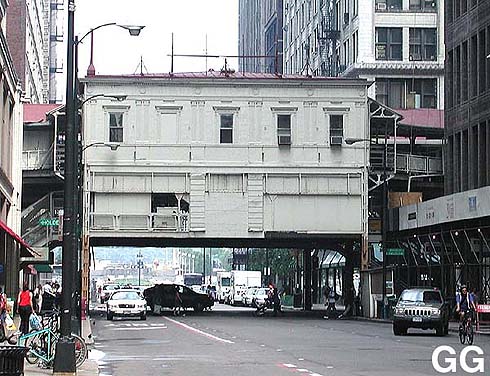
The Palladian design of the
Madison/Wabash station house -- similar to Quincy/Wells
-- features Corinthian pilasters, window surrounds
resembling the Baroque style and cartouches along the
roofline. It is the last of the original Wabash elevated
stations and, despite a somewhat rough appearance, is
imminently restorable. This view looks east in August 2001.
For a larger view, click here.
(Photo by Graham
Garfield)
|
Madison/Wabash
(1N-S/45E)
Madison Street and Wabash
Avenue, Loop
Service
Notes:

|
Loop |
Quick Facts:
Address: 2 N. Wabash
Avenue
Established: November 8, 1896
Original Line: Union Elevated Railroad
Previous Names: none
|
Skip-Stop Type:
|

|
Station
|
Rebuilt: n/a
Status: Demolished
History:
The Union Elevated Railroad, backed by transit magnate Charles
Tyson Yerkes, was incorporated on November 22, 1894 to construct a
loop around the central business district, connecting the three
elevated lines that until 1897 ended at individual terminals.
Obtaining sufficient frontage signatures (required from business
owners along the affected route) for the east leg of the Loop was
particularly difficult, since nearly all the retailers opposed the
presence of a hulking steel structure in front of their store. After
a long campaign, Union Loop representatives eventually convinced
property owners that the "L" would increase their property values,
not hurt them. A franchise was finally granted on October 14,
1895.
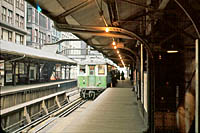
Madison/Wabash's platforms
are seen looking south on the Inner Loop platform in 1961.
The station looks largely the same today, save for the
replacement of the incandescent lights. The 4000-series Lake
"A" train is traveling on what would today be the southbound
track, but it coming toward the camera because until 1969
the look was a unidirectional railroad, with traffic on both
tracks operating counterclockwise. For a larger view, click
here.
(Photo from the IRM Collection,
courtesy of Peter Vesic)
|
The structure between Adams and Lake was placed in service November
8, 1896, thus activating the Madison/Wabash station. At this point,
the only section in service was the L formed by the Lake and Wabash
legs, meaning that only the Lake Street Elevated was connected to the
system. The Lake Street operated the first train here and had the
tracks (and direct downtown access) to itself for the time being.
Trains were operated bi-directionally using the right-hand track
until the entire Loop was opened. The first Metropolitan "L" train
used the station on October 11, 1897 and the South Side followed suit
on October 18.
Madison is the last stop on the east leg of the Loop to retain its
original station house. Adams/Wabash's
station houses were removed in the mid-1960s and the station was
seriously altered in 1988-89; Randolph/Wabash's
Inner Loop house was removed and replaced in 1955-57 and the Outer
Loop was demolished in the mid-1960s.
The Inner Loop station house is executed in painted sheet metal.
The Palladian design is similar to Quincy/Wells,
featuring Corinthian pilasters, window surrounds resembling the
Baroque style and cartouches along the roofline. Madison/Wabash
station employed the first direct entrance between an "L" station and
an adjacent building, later a common element. In 1900, the Union
Elevated constructed a covered passageway between the station and the
Schlesinger & Mayer department store (now Carson Pirie Scott
& Company). The construction of the direct entrance caused no
small amount of controversy, as Mayor Carter H. Harrison argued that
a direct entrance constituted a private use of a street, which the
city council was not permitted to grant (though this contradicted the
authorized presence of utilities, streetcars, pushcart vendors, and
the elevated itself). Harrison ordered all work stopped. Lawyers for
Schlesinger & Mayer obtained a restraining order against the city
to allow work to be completed, but to belabor the point the Union
Elevated announced that the actions of the city had violated the
city's own ordinances, thus excusing the elevated from continuing to
pay the city the compensation required under their franchise.
Harrison upped the ante by threatening to repeal the franchise for
the Van Buren leg of the Loop, so the president of the Union Elevated
capitulated and paid the fees. But it would not be the last time the
city and the Union Elevated would lock horns over what would seem to
be a simple improvement for the benefit of the public. The covered
passgeway and direct entrance have since been removed.
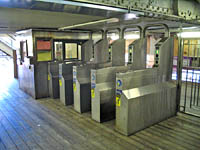
Madison/Wabash's
mezzanine-level fare controls -- tried for the first time
anywhere on the "L" here circa 1930 -- are seen here looking
southeast on October 17, 2004. Obviously, the turnstiles and
booth in use today are more recent. The low ceiling
clearance gives the space a confined atmosphere. For a
larger view, click here.
(Photo by Tony
Coppoletta)
|
In the 1930s, the Chicago Rapid Transit moved the fare controls for
Madison/Wabash out of the twin track-level station houses and onto a
mezzanine level, connecting the platforms beneath the tracks, above
the street. It was one of the CRT's early experiments with
consolidating seperated fare controls, which brought both functional
and labor economies by eliminating multiple fare controls in a single
station. After this point, the station houses closed to public use.
The interior is currently used as the
CTA's Loop Transportation
Office, but does retain much of its original interior detailing. The
stairways directly into the station house are closed off, but the
ones directly onto the platform remain in use.
In 1982, Madison/Wabash was among a group of stations that became
the first Part-Time service stations, closed nights, holidays, and
all or part of the weekend. The reduction in service was an economy
move to save on labor expendatures at a time when
CTA's costs were spiraling out
of control. It's status as a Part-Time station continued until
Monday, June 5, 2000, when CTA President Frank Kruesi announced at a press conference that beginning
Saturday, June 10th and Sunday, June 11th, six downtown area 'L' and
subway stations and seven station entrances that were closed late at
night or on weekends would be open at all hours that trains are in
service. One of the stations that was a Part-Time Station -- closed
Sundays and Holidays -- was Madison/Wabash. Starting at 0700 hours
Sunday, June 11th, Madison/Wabash returned to full-time operation.
Opening these stations and entrances is just one of the components of
a $539,000 service improvement package that was passed by the Chicago
Transit Board in May 2000.
The platforms sport some original railings and all of the original
canopies, as well as the 1910s platform/canopy extensions, new-style
symbol signs and KDR-style name signs. Madison/Wabash also still has
its vintage pedestrian bridge.
Plans for Renovation and
Consolidation
The Randolph/Wabash and
Madison/Wabash stations have been targets for demolition and
consolidation for some time. As early as November 1981,
CTA planned to
demolish them and construct a new facility at Washington/Wabash. A
1983 plan again reiterated this goal. The plan was regularly
resurrected ever since.
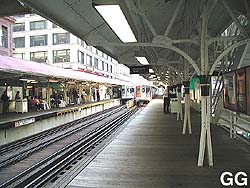
Looking north on the
Madison/Wabash Outer Loop platform in August 2001. The
platforms feature original canopy ironwork. A Harlem-bound
Green Line train is pulling away as a Midway-bound Orange
Line train pulls in. For a larger view, click
here.
(Photo by Graham
Garfield)
|
More recently, a plan discussed by the CTA in 1998 had the new station placed between Randolph and Washington.
In this $29 million version, the new station was to have entrances
and/or transit card gates on Randolph, Wabash and Washington. On
September 11, 1998, when the CTA announced that they planned to permanently close the State/Lake
and Madison/Wabash elevated stations and replace the Randolph/Wabash
facility with a "super station." Supposedly combining function,
aesthetics and the need to replace "L" structures that date to the
1890s, the new station would have become the third-busiest station in
the CTA's 142-station system and would've included a pedway connection to the
Red Line subway one block away. The design of the new station, which
is undergoing final review by officials from the city, the
CTA and the
Greater State Street Council, was described as a traditional, but
modernized version of the Madison/Wabash station. As part of the
construction work, the entire elevated structure was to be rebuilt
from Lake to Washington Streets and the supports down the middle of
Wabash would've been replaced by columns anchored along the
curbs.
The consolidation plan languished for several years after, but did
not disappear entirely. The designs from the late-1990s were
apparently shelved, as the plan to consolidate three stations --
State/Lake, Randolph/Wabash
and Madison/Wabash -- was revised in favor of only consolidating the
latter two, leaving State/Lake to be
replaced with a new station facility east of State Street. An
intergovernmental agreement was approved at the April 3, 2003
CTA Board
providing $1 million to the Chicago Department of Transportation
(CDOT) for preliminary design and engineering work for the
construction of a new station at Washington and Wabash. The
CTA will work
with CDOT to design the station.
Accessibility at the new Washington/Wabash station will be
provided by both elevators and escalators. There will also be
stairways to both platforms. The platforms will have bright lighting,
a communications system with both digital and audio messaging, and
windbreaks equipped with overhead heaters for customer comfort during
inclement weather. The new facility, to be located between the
existing facilities, will be large enough to accommodate customer
traffic at both locations.
The planned construction of a new Washington/Wabash station
mirrors work completed on the Wells side of the Loop in the
mid-1990s. There, stations at Randolph
and Madison were also demolished and
replaced with an intermediate stop at Washington.
This reduced the number of stations on the west leg of the Loop from
three to two, the same number as on the north (Lake) and south (Van
Buren) legs of the Loop Elevated (the latter achieving two stops
after the opening of Library station in
1997). Replacing the Randolph and
Madison stations on the Wabash side will put two stations uniformly
on all four sides of the Loop. The new Washington/Wabash station,
like its Wells Street cousin, will seemingly be not over Washington
itself but between Washington and Madison, with the south portion of
the station probably continuing over Madison Street. This is borne
out by the staging of the project, in which the first phase will
require closing and demolishing the Madison/Wabash station to allow
new construction to begin. The Randolph/Wabash
station is to remain open until the new station is completed. The
placement of the new station is such that it would seem to allow the
retention of the historic Madison/Wabash station house, which is
within the boundaries of a proposed Jeweler's Row historic district.
Preservation of the Madison station has not emerged as a part of
CDOT's plans, but the designs are at an early stage and are still
developing. The loss of the Madison/Wabash station would represent a
significant loss to the history and architecture of the "L".
Madison/Wabash is the last remaining example of the original 1896
Loop architecture from the Wabash Avenue side. Details about the
project will be determined when the design is finalized.
For more information about the proposed station consolidation, see the Washington/Wabash page.
In March 2014, Preservation Chicago, an architectural preservation group that releases an annual list of Chicago's seven most endangered buildings, included the Madison/Wabash station on its 2014 list, noting that it is the last original "L" station house on the east leg of the Loop. Ward Miller, executive director of Preservation Chicago, said his historic advocacy group would like to work with CDOT and the CTA to save items from the stations for display in local museums or integration into other stations. In March 2015, CDOT spokesman Mike Claffey said the city and the CTA are reviewing items that could be salvaged including railings, benches and signs. "We're trying to come to some good compromise and resolution on trying to save components of these stations," Miller said.1
The Madison/Wabash station closed at approximately 1:45am, Monday, March 16, 2015, for the construction of the new Washington/Wabash station, with demolition to begin soon after.
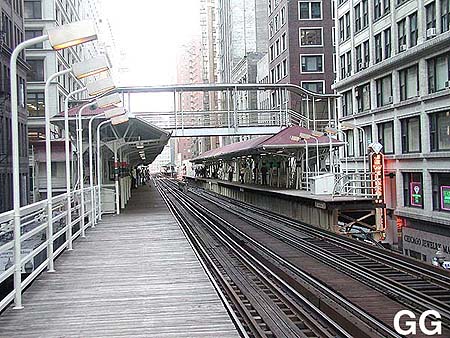
The historic Madison/Wabash
station, looking north on the Inner Loop platform in August
2001. The canopies are all original, as is the track-level
station house visible on the left. The overhead bridge was
added in the 1910s, but is historic nonetheless. Madison is
one of the few remaining examples of early Loop design. For
a larger view, click here.
(Photo by Graham
Garfield)
|

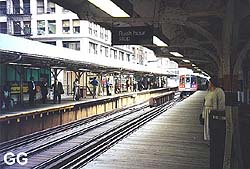
|
madison-wabash03.jpg
(62k)
The Madison/Wabash platforms, looking southeast on June 8,
1999. An East 63rd Branch Green Line train has pulled out
and is heading toward Adams.
The green plastic panels in the center left cover an area
previously occupied by the outer station
house. (Photo by Graham Garfield)
|
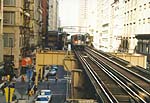
|
madison-wabash04.jpg
(78k)
The Madison/Wabash station, looking north from Adams/Wabash.
A Green Line train has left Madison and is heading toward
63rd Street. (Photo by John F.
Kuczaj)
|
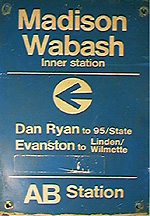
|
madison-wabashSign.jpg
(28k)
Madison/Wabash symbol sign from the inner (west) platform.
The strip under "Evanston" on the bottom used to list the
Loop Shuttle service, discontinued in 1977.
(Sign from the collection of Graham Garfield)
|
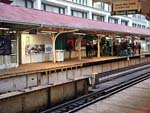
|
Spiderman2-Madison.jpg
(171k)
Columbia Pictures did extensive shooting on location in
Chicago for the Spiderman movie sequel, The
Amazing Spider-Man. Madison/Wabash station was fixed up
to stand in as the fictional "Broadway" station on the R
Line el (also fictional) for Spiderman 2. This view looks
northwest at the Inner Loop platform on November 16, 2002.
(Photo by Graham Garfield)
|

|
madison-wabash01.jpg
(143k)
The Madison/Wabash Inner Loop signage was changed for the
filming of Shall
We Dance?, as seen on September 6, 2003, to
transform the station into Sedgwick.
Ironically, they used the Current
Graphic Standard format (modified and poorly-imitated)
for the faux-signs, but Sedgwick
actually as KDR-style
station name signs. Also, notice how while the name of the
station was changed, the directional coordinates for
Madison/Wabash, not
Sedgwick were used.
(Photo by Kevin Zolkiewicz)
|

|
madison-wabash02.jpg
(121k)
In addition to the station name signs, the symbols signs
were modified to cover up the Madison
name. However, rather than transform them into Sedgwick
signs, the colored bars representing the lines serving the
platform (none of which actually serve Sedgwick)
were left and the name was covered with an arrow whose
intended meaning is not altogether clear...
(Photo by Kevin Zolkiewicz)
|

|
cta2246.jpg
(136k)
A four-car midday northbound (somewhat dusty looking)
Lake-Dan Ryan "B" train is trailed by car 2246 as it pulls
into Madison/Wabash on April 11, 1977. Note the yellow
sticker over the motorman's window on the #1 end of the car:
the 2200s used to
have stickers that said "Air Conditioned" at a time when
most of the fleet was still without A/C.
(Photo by Ed McKernen, Collection of
Joe Testagrose)
|
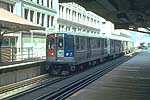
|
cta2454.jpg
Car 2454 leads a four-car train bound for the
East 63rd branch of the Green Line at Madison/Wabash on
March 3, 2001. (Photo by Mike
Farrell)
|
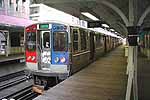
|
cta2431.jpg
(93k)
2400-series car
2431 is at the rear of a northbound Green Line train stopped
at Madison/Wabash on December 28, 2001.
(Photo by Graham Garfield)
|
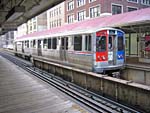
|
cta2551.jpg
(197k)
By the Spring of 2006, as the
CTA continues to
change its railcar fleet to all silver/gray exterior,
relatively few 2400-series
cars remained with red, white, and blue end caps and belt
rails. On April 12, 2006, cars 2551-52, seen passing
Madison/Wabash northbound,
were chosen specifically for a charter run for railfan David
Harrison because they still retained this increasingly-rare
livery. (Photo by Graham
Garfield)
|
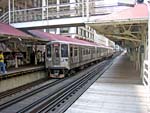
|
cta2219c.jpg
(208k)
A 4-car Pink Line training train is lead by Budd car 2219,
simulating a stop at Madison/Wabash
on June 7, 2006. Note that the proper destination signs have
been installed and the marker lights programmed. The markers
chosen for the Pink
Line -- white-red -- not only combine ti make pink but
were the Douglas Park branch's original marker lights under
the Metropolitan Elevated from when the line began service
in 1896 until it was through-routed as part of the West-Northwest
Route in 1958, making them a return to the line's
heritage. (Photo by Graham
Garfield)
|


- madison-wabash.wav
(22K): Conductor announcemes, "Madison & Wabash is
next."
.
- Madison-Wabash_next.wav
(151k): Pre-recorded announcement: "Madison and Wabash is
next. Doors open on the right at Madison and
Wabash." (Sound
courtesy of Tony Coppoletta)
Notes:
1. Swartz, Tracy. "Madison/Wabash 'L' station to close March 16". Red Eye. March 2, 2015.


















